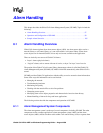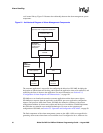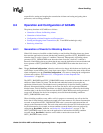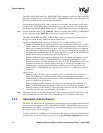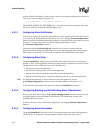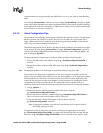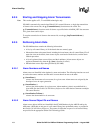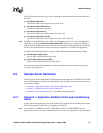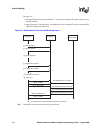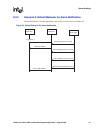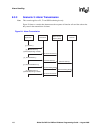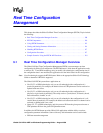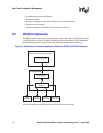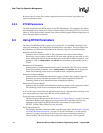
Global Call API for HMP on Windows Programming Guide — August 2006 105
Alarm Handling
The following functions are used to retrieve ASO names and IDs and to convert them from one to
the other:
gc_AlarmSourceObjectID( )
retrieves the alarm source object ID, for a given event
gc_AlarmSourceObjectIDToName( )
converts an alarm source object ID
gc_AlarmSourceObjectName( )
retrieves the alarm source object name, for a given event
gc_AlarmSourceObjectNameToID( )
converts the alarm source object name to the alarm source object ID
Note: GCAMS uses predefined IDs for the ASOs it has implemented, however it is recommended that
applications use the gc_AlarmSourceObjectNameToID( ) function to associate the ASO name
with an ID rather than using the ID directly. This allows for more flexible applications if ASOs that
reside in call control libraries and have dynamically assigned IDs are added to the application.
In addition, the following functions are used to obtain additional information about the ASOs:
gc_GetAlarmSourceObjectList( )
gets all ASOs associated with a line device
gc_GetAlarmSourceObjectNetworkID( )
gets the network ID associated with a line device.
For more information on these functions, see the individual function descriptions in the Global
Call API Library Reference.
8.3 Sample Alarm Scenarios
The following scenarios illustrate the relationship between the application, GCAMS, and the AOS
and provide examples of alarm system configurations, and the sequence for transmission of alarms.
The scenarios include:
• Scenario 1: Application Notified of First and Last Blocking Alarm
• Scenario 2: Default Behavior for Alarm Notification
• Scenario 3: Alarm Transmission (E1, T1 and ISDN technologies only)
8.3.1 Scenario 1: Application Notified of First and Last Blocking
Alarm
In this scenario, the application wants to be notified of only the first and last blocking alarm events.
The default blocking configuration is acceptable. See Figure 22.
Note: If both a GCEV_ALARM and a GCEV_BLOCKED (or GCEV_UNBLOCKED) event are
generated for an alarm, the order in which these events are sent to the application is not guaranteed.



